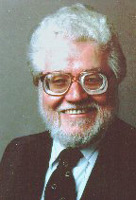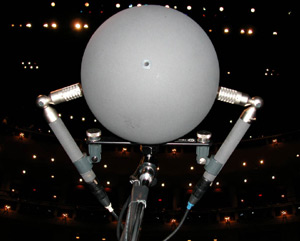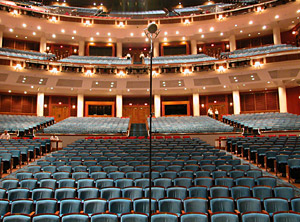![[SoundStage!]](../sslogo3.gif) Surrounded! Surrounded!Back Issue Article |
|
March 2002 An Interview with Jerry Bruck on KFM 360 Surround-Sound Recording  Jerry
Bruck developed the KFM 360 surround recording technique used by Peter McGrath, who was
written about in January and February. Jerry owns Posthorn
Recordings, where he has been the residing recording engineer for over 30 years. He is
a Fellow of the Audio Engineering Society, and is regarded as a pioneer of surround
recording technology. Jerry
Bruck developed the KFM 360 surround recording technique used by Peter McGrath, who was
written about in January and February. Jerry owns Posthorn
Recordings, where he has been the residing recording engineer for over 30 years. He is
a Fellow of the Audio Engineering Society, and is regarded as a pioneer of surround
recording technology.
Jeff Fritz: Explain to us the concept of the KFM 360. Jerry Bruck: The KFM 360 surround concept takes its cue from the innovative Sphere microphone devised by the German researcher Dr. Gunther Theile. The original KFM was first produced as a commercial product by Schoeps as their KFM 6 stereo microphone. It consists of a pair of omni-directional microphones, flush-mounted across from each other on an eight-inch ball. At first glance, it looks like a "dummy head" without human features, but listening to a recording made with it over loudspeakers is a revelation. Unlike a binaural "dummy head" or a pair of "A-B" spaced omni microphones, it recreates an accurate stereo image with a marvelous sense of depth. Used as a point-source stereo microphone, it has no equal for sheer naturalness. It seemed promising as the basic element of a purist surround mike setup. Some years back I delivered a paper at the annual convention of the Audio Engineering Society on a "Mid-Side Boundary Layer" technique I had devised. It was an adaptation of the classic "Mid-Side" stereo arrangement described by the great British inventor, Alan Blumlein, in a patent dating back to 1935 (as it happens, the year of my birth). Blumlein proposed placing a figure-of-eight microphone sideways, facing away from the sound source, and pairing it with a directional mike placed midway on top of it, pointing forward at the sound source. By matrixing the output of these two mikes -- really a fancy term for mixing them both in and out of phase and feeding them into two channels -- the result would be a pair of virtual microphones pointing left and right similar to a conventional "X-Y" stereo pair. By adjusting the proportions of the mix, the reproduced stereo image could be narrowed or widened, and the perspective moved further away from or closer to the sound source. Brilliant! My modest proposal was to substitute a boundary-layer microphone for the "Mid" element in this setup. This would make a stereo pickup that would be useful for low-profile stage miking and similar uses. I remember wondering at the time what might happen if the boundary was the surface of a sphere, but I couldn't think of a practical application. Put that with the guy who invented a soft drink and wanted to name it "Something-UP," with the "Something" being a number preceding the "UP." According to the late Victor Borge, he abandoned the idea after "6."
A quarter of a century ago I had experimented with quadraphonic recording, using various purist rigs (including the "Soundfield Microphone") that at least proved to me that the notion of "surround sound" had merit. Lacking any consumer format that made sense, Quad quickly joined the Edsel, the Elcaset, and celibacy between consenting adults, as something less than an idea whose time had come. It took Francis Ford Coppola's whirring helicopters playing Wagner to set my mind awhirl with notions for implementing surround sound anew. I didn't wait for the Schoeps KFM 6 to fall off its mike stand like a modern day Newtonian apple to realize that a Mid-Side pair could reproduce front-to-back images as easily as left-to-right. Rather than thinking outside the box, call it "thinking outside the sphere." Suddenly it dawned on me that placing figure-of-eight mikes athwart the KFM 6 was a potential recipe for surround-sound Nirvana. And so it proved to be. That combination, processed through a "Double Mid-Side" matrix, produces complementary stereo images fore and aft, and even side images that work! Take away the eights, you have stereo; put 'em back, you have surround, pure, potent, and pleasurable. JF: Do you feel that four channels are optimal for recording music, especially compared to the industry standard (for video) 5.1 configuration? Why or why not? JB: You can add a center channel and subs to the KFM 360, but they're not really needed. For any surround system reproducing music, that center channel can be finicky. I know mastering engineers who, transferring classical music in surround, turn the center channel way down or off. Feeding the point-one subwoofer is even trickier, since you don't know the layout or absolute quality of the listener's speakers, not to mention the room acoustics. "KISS" may be the best way to go, all things considered. JF: What fundamental advantages does KFM 360 have over stereo in terms of capturing the event on the recording and actual playback in the home? JB: The ambient information so necessary for the feeling of being there is relocated to the sides and rear in surround, where it originated. To an extent, this can even swamp the room acoustics, which otherwise color the ambient sound along with the musical program when listening in stereo. A prerequisite of any good surround system is that the listening area should broaden. When experiencing a KFM 360 recording being played back, moving around the room is like changing your seat in the concert hall. JF: What are your current thoughts on multichannel SACD and DVD-Audio, and where do you see the industry going over the next few years? JB: To the dogs! That howling you hear is from producers, recording engineers, and musicians, who, having devoted a major part of their lives (and livelihoods) to the pursuit of artistic goals, are now discovering that what they have worked so diligently to create is finding less and less of a market. The many distractions of cable and satellite TV piped into home theaters and the ubiquitous computer screen flickering with a cornucopia of Internet buyhere.coms, flashy games, chat rooms, and good 'ol porn, wield at least for the moment a fascination that borders on a honky-tonk Sesame Street for adults (or wannabees). The notion that we might just want to sit quietly in a darkened room without a screen to focus on and listen to music penned a few decades ago by hapless humans who left the scene too early to place bids on eBay, seems truly retro in the current clime. For some at least, these are dog days. JF: Tell us about some of your favorite surround recordings. JB: Peter McGrath was an early convert to the KFM 360 concept, and his concert recordings show its virtues admirably, particularly when reproducing classical music in its natural setting is the paramount objective. Others have followed, but are hampered by the lack of available surround media. So far, one of the CDs I made for JMR (John Marks Recordings) has been released on DTS [Reverie: Image JMR 10S/ID4687JMDTSC]. In addition to concerts, I've made some recordings outdoors as well, with highly satisfying results in recreating natural ambiences. For recording jazz or pop music, the challenge is greater. The KFM 360's total lack of gimmickry makes it unsuitable for whiz-bang special effects and rotating ambiences, but there are lots of arcades you can pop into if that's your taste. Otherwise, Peter and I are angling for eventual release on DVD-Audio and SACD. JF: What type of home playback system do you listen to? JB: I have an authentic 1902 Edison "Gem" Cylinder Phonograph with an unfolded horn attachment for extra oomph. It still works (something I worry about with much of today's equipment and formats), but I can't turn it up without the neighbors complaining, so I resort to my Waveform Mach 17s or Aerial 10Ts, driven by a motley assortment of amps and front ends, with a Nagra D as a surround source. I've got five years of my own KFM 360 tapes to listen to, and a few of Peter's as well, so I can afford to wait for the rest of today's surround technology to settle down. Meanwhile, I just want to be there, whenever I want.
|
|
|
|
![[SoundStage!]](../sslogo3.gif) All Contents All ContentsCopyright © 2002 SoundStage! All Rights Reserved |

